| dc.contributor.advisor | Beizaga Ramírez, Walter Claudio | |
| dc.contributor.author | Velasco Castro, Geanella Dayana | |
| dc.contributor.author | Lucana García, Yefrey Alfredo | |
| dc.date.accessioned | 2022-11-30T21:49:14Z | |
| dc.date.available | 2022-11-30T21:49:14Z | |
| dc.date.issued | 2022-08-24 | |
| dc.identifier.uri | https://hdl.handle.net/20.500.12557/4973 | |
| dc.description.abstract | La presente investigación tuvo como objetivo cuantificar la incidencia del gasto
social en los principales indicadores de desarrollo social en la región Cusco en el periodo
2016 – 2020, usando la metodología a través de la asignación y ejecución presupuestal
por la cadena funcional programática según criterios establecidos a nivel internacional
por la CEPAL, luego de realizar la recopilación de información necesaria para la
investigación se procedió con la estimación del gasto social total, el que en promedio
representa el 67.5% del presupuesto total asignado anualmente, según las funciones
Educación, Protección Social, Salud, Cultura y Deporte; el que se divide en gasto social
básico que representa en promedio el 65% del presupuesto total y gasto social
complementario que representa en promedio el 2.5% del presupuesto total.
También se ha recogido datos sobre pobreza monetaria y pobreza monetaria
extrema en la Región de Cusco que en promedio en los últimos seis años alcanza 23.50%
y 3.60% respectivamente, de la misma forma se ha registrado respecto a otro indicador
de desarrollo social, la desnutrición crónica en menores de 5 años con el valor promedio
de 14.30% en los últimos 6 años. Para cuantificar la incidencia del gasto social estimado
y las variables pobreza y desnutrición, se han corrido modelos econométricos usando
además la metodología de Mínimos Cuadrados Ordinarios donde los resultados fueron
que la relación entre el gasto social y la Desnutrición Crónica Infantil es negativa y se
requiere asignar un millón de soles para disminuir 0.027 puntos porcentuales; así mismo
en el caso de la relación entre el gasto social y la pobreza monetaria extrema el análisis
resulto en una relación positiva que tiene un coeficiente 0.24 en ambos casos en
coeficiente de determinación R^2 fue de 0.39 y 0.41 respectivamente. | es_PE |
| dc.description.abstract | The objective of this research was to quantify the incidence of social spending on
the main indicators of social development in the Cusco region in the period 2016 - 2020,
using the methodology through budget allocation and execution by the programmatic
functional chain according to criteria established internationally by ECLAC, after
carrying out the collection of data necessary for the investigation proceeded with the
estimation of total social spending, which on average represents 67.5% of the total budget
allocated annually, according to the functions Education, Social Protection, Health,
Culture and Sports; which is divided into basic social spending that represents an average
of 65% of the total budget and complementary social spending that represents an average
of 2.5% of the total budget.
Data has also been collected on monetary poverty and extreme monetary poverty
in the Cusco, which on average in the last six years reaches 23.50% and 3.60%
respectively, in the same way it has been registered with respect to another indicator of
social development, malnutrition. chronic in children under 5 years with the average
value of 14.30% in the last 6 years. To quantify the incidence of estimated social
spending and the poverty and malnutrition variables, econometric models have been run
using the Ordinary Least Squares methodology, where the results were that the
relationship between social spending and Child Chronic Malnutrition is negative and it
is required to allocate one million soles to reduce 0.027 percentage points; Likewise, in
the case of the relationship between social spending and extreme monetary poverty, the
analysis resulted in a positive relationship that has a coefficient of 0.24. In both cases,
the coefficient of determination R^2 was 0.39 and 0.41, respectively. | en_US |
| dc.format | application/pdf | es_PE |
| dc.language.iso | spa | es_PE |
| dc.publisher | Universidad Andina del Cusco | es_PE |
| dc.rights | info:eu-repo/semantics/openAccess | es_PE |
| dc.rights.uri | https://creativecommons.org/licenses/by-nc-nd/4.0/ | es_PE |
| dc.subject | Gasto social | es_PE |
| dc.subject | Desnutrición crónica infantil | es_PE |
| dc.subject | Gobiernos regionales | es_PE |
| dc.title | El gasto social y su impacto en los principales indicadores de desarrollo social en la región del Cusco en el periodo 2016-2020 | es_PE |
| dc.type | info:eu-repo/semantics/bachelorThesis | es_PE |
| thesis.degree.name | Economista | es_PE |
| thesis.degree.grantor | Universidad Andina del Cusco. Facultad de Ciencias Económicas, Administrativas y Contables | es_PE |
| thesis.degree.discipline | Economía | es_PE |
| dc.publisher.country | PE | es_PE |
| dc.subject.ocde | https://purl.org/pe-repo/ocde/ford#5.02.04 | es_PE |
| renati.advisor.dni | 23821642 | |
| renati.advisor.orcid | https://orcid.org/0000-0001-9232-2063 | es_PE |
| renati.author.dni | 76078104 | |
| renati.author.dni | 72373050 | |
| renati.discipline | 311016 | es_PE |
| renati.juror | Carrillo Segovia, María Jesús | |
| renati.juror | Galdos Berrío, Ilberto | |
| renati.juror | Flores Lucana, Ignacio Ramiro | |
| renati.juror | Paullo Tisoc, Rocio | |
| renati.level | https://purl.org/pe-repo/renati/level#tituloProfesional | es_PE |
| renati.type | https://purl.org/pe-repo/renati/type#tesis | es_PE |


